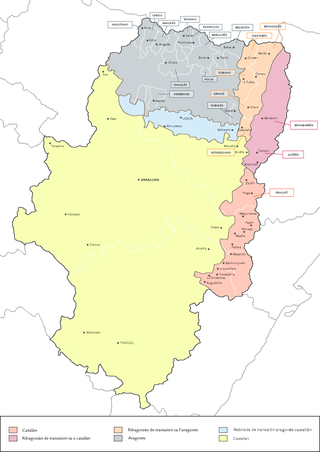
Aragonese is a Romance language spoken in several dialects by about 12,000 people as of 2011, in the Pyrenees valleys of Aragon, Spain, primarily in the comarcas of Somontano de Barbastro, Jacetania, Alto Gállego, Sobrarbe, and Ribagorza/Ribagorça. It is the only modern language which survived from medieval Navarro-Aragonese in a form distinctly different from Spanish.
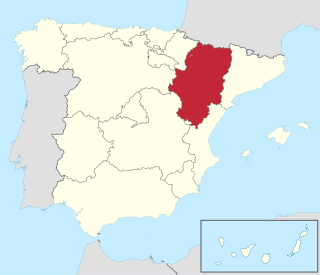
Aragon is an autonomous community in Spain, coextensive with the medieval Kingdom of Aragon. In northeastern Spain, the Aragonese autonomous community comprises three provinces : Huesca, Zaragoza, and Teruel. Its capital is Zaragoza. The current Statute of Autonomy declares Aragon a historic nationality of Spain.
Ribagorçan is a number of Romance dialects spoken in the modern territories of the medieval County of Ribagorza, in northern Spain.

The County of Ribagorza or Ribagorça was a medieval county on the southern side of the Pyrenees, including the northeast of modern Aragón and part of the northwest of modern Catalonia, both in Spain. It was originally the independent creation of a local dynasty, later absorbed into the Kingdom of Navarre and then into the Crown of Aragon. It had a strong historical connection with the neighboring counties of Sobrarbe and Pallars. Its territory consisted of the valleys of the rivers Ésera, Isábena, and Noguera Ribagorzana. The seat of its counts was at Benabarre. Other notable towns include Benasque, Graus and Pont de Suert. Today the western portion of the county roughly corresponds to the Aragonese comarca of Ribagorza, with its administrative centre in Graus; the eastern portion roughly corresponds to the Catalan comarca of Alta Ribagorça.

Huesca, officially Huesca/Uesca, is a province of northeastern Spain, in northern Aragon. The capital is Huesca.
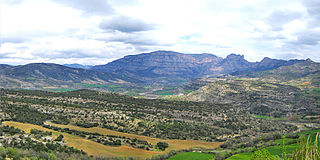
Ribagorça or Ribagorza is a historical and natural region of Aragon and Catalonia. Located in the Pre-Pyrenees and Pyrenees area, most of its territory is mountainous. The region has been steadily losing population since mid 20th century.

Benasque is a town in the comarca of Ribagorza, province of Huesca, (Spain). It is the main town in the Benasque Valley, located in the heart of the Pyrenees and surrounded by the highest peaks in that range.

Some of the regional varieties of the Spanish language are quite divergent from one another, especially in pronunciation and vocabulary, and less so in grammar.

La Franja is the area of Catalan-speaking territories of eastern Aragon bordering Catalonia, in Spain. It literally means "the strip" and can also more properly be called Franja d'Aragó, Franja de Ponent or Franja Oriental d'Aragó in Catalan.
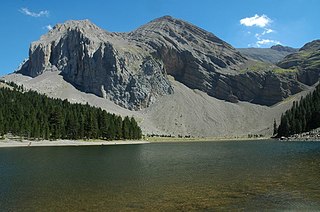
Sobrarbe is one of the comarcas of Aragon, Spain. It is located in the northern part of the province of Huesca, part of the autonomous community of Aragon in Spain. Many of its people speak the Aragonese language locally known as fabla.
Josep Carles Laínez is a Spanish writer who lives in Valencia, Spain and Encamp, Andorra. A graduate of the University of Valencia in Catalan and Spanish Philology and Audio-visual Communication, his main interest is in European minority languages, and he has published original books and/or articles in Catalan, English, Spanish, Occitan, Aragonese and Asturian. He is currently the Editor-in-chief of the literary-philosophical quarterly journal Debats.
Ny is a digraph in a number of languages such as Catalan, Ganda, Filipino/Tagalog, Hungarian, Swahili and Malay. In most of these languages, including all of the ones named above, it denotes the palatal nasal. To represent the palatal nasal in other languages, the letter nj is used, such as in Albanian and the countries using Gaj's Latin alphabet and the countries that make up the former Yugoslavia.

Campo is a town in the county of Ribagorza, in the province of Huesca, in Aragon, Spain. Situated in a valley between 2 rivers, the Esera and Rialbo, it is surrounded by snow-capped Pyrenean mountain peaks: most notably, the Turbón and Cotiella.

Aragonese literature of Spain includes Aragonese-language poetry, prose and novels.
Rosario Ustáriz Borra was a writer and poet who wrote in the Aragonese language, born in the Pyrenean village of Hecho, in the Province of Huesca, and a native speaker to the Aragonese Cheso dialect, in which she developed the whole of her work. As one of the few native speakers of modern Aragonese that have taken some part in its divulgation and conservation, Ustáriz is well appreciated among the community of scholars and supportants of this Pyrenean vernacular, having some of her works been published.
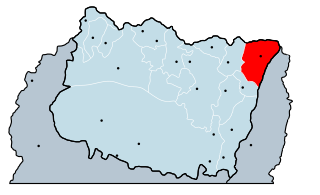
Benasquese, often called patués by its speakers, is the native Romance linguistic variety of the Valley of Benasque, in the province of Huesca.
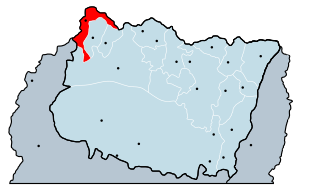
Ansó Aragonese is a variety of Western Aragonese spoken in Ansó Valley, included Ansó, Biniés and Fago.

Hecho Aragonese, or Cheso, is a Western Aragonese variety spoken in the Hecho Valley of Northern Aragon.
This article discusses the conjugation of verbs in a number of varieties of Catalan, including Old Catalan. Each verbal form is accompanied by its phonetic transcription. Widely used dialectal forms are included, even if they are not considered standard in either of the written norms: those of the Institut d'Estudis Catalans and the Acadèmia Valenciana de la Llengua. Other dialectal forms exist, including those characteristic of minor dialects such as Ribagorçan and Algherese and transitional forms of major dialects.

Ribagorza ; or Ribagorça is a comarca (county) in Aragon, Spain, situated in the north-east of the province of Huesca. It borders the French département of the Haute-Garonne to the north and Catalonia to the east. Within Aragon its neighboring counties are Sobrarbe, Somontano de Barbastro, and La Litera. It roughly corresponds to the Aragonese part of the medieval County of Ribagorza. The administrative capital of Ribagorza is Graus, although the historical capital of the county was at Benabarre.















